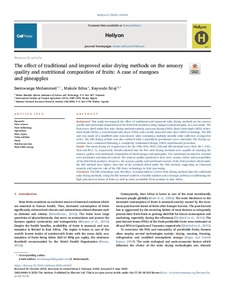| dc.contributor.author | Ssemwanga, M. |
| dc.contributor.author | Makule, E. |
| dc.contributor.author | Kayondo, S. |
| dc.date.accessioned | 2020-09-29T12:34:47Z |
| dc.date.available | 2020-09-29T12:34:47Z |
| dc.date.issued | 2020-06 |
| dc.identifier.citation | Ssemwanga, M., Makule, E. & Kayondo, S. (2020). The effect of traditional and improved solar drying methods on the sensory quality and nutritional composition of fruits: a case of mangoes and pineapples. Heliyon, 6(6), e04163: 1-10. |
| dc.identifier.issn | 2405-8440 |
| dc.identifier.uri | https://hdl.handle.net/20.500.12478/6956 |
| dc.description.abstract | Background
This study investigated the effect of traditional and improved solar drying methods on the sensory quality and nutritional composition of the dried fruit products; using mangoes and pineapples, as a case study. The fruits were dried under five solar drying methods namely; open sun drying (OSD), black-cloth shade (BCS), white-cloth shade (WCS), a conventional solar dryer (CSD), and a newly improved solar dryer (ISD) technology. The ISD unit was made of a modified solar concentrator plate containing multiple metallic solar collectors arranged in series. The ISD drying cabinet was also enclosed with a specialized greenhouse cover materials. The drying operations were conducted following a completely randomized design (CRD) experimental procedure.
Results
The mean drying air temperatures for the OSD, BCS, WCS, CSD and ISD methods were 26.8, 26.7, 24.5, 32.6 and 40.3 °C; respectively. Results showed that the five solar drying methods were capable of retaining the sensory quality and nutritional composition of dried mango and pineapples. The nutritional parameters retained were proximate and mineral content. The sensory quality parameters were taste, aroma, colour and acceptability of the dried fruit products. However, the sensory quality and nutritional content of the fruit products dried under the ISD method were higher than that of the products dried under the CSD method, suggesting an enhanced capacity and superior role of the ISD dryer technology in fruit processing.
Conclusion
The ISD technology was, therefore, recommended as a better fruit drying method than the traditional solar drying methods. Using the ISD method could be a feasible solution and a strategic pathway to addressing the high post-harvest losses of fruits as well as other perishable fresh produce in East Africa. |
| dc.description.sponsorship | German Academic Exchange Service |
| dc.format.extent | 1-10 |
| dc.language.iso | en |
| dc.subject | Food Science |
| dc.subject | Food Technology |
| dc.subject | Agriculture |
| dc.subject | Solar Drying |
| dc.subject | Value Systems |
| dc.subject | Fruits |
| dc.subject | Postharvest Losses |
| dc.subject | Renewable Energy |
| dc.subject | Pineapples |
| dc.subject | Mangoes |
| dc.title | The effect of traditional and improved solar drying methods on the sensory quality and nutritional composition of fruits: a case of mangoes and pineapples |
| dc.type | Journal Article |
| cg.contributor.crp | Roots, Tubers and Bananas |
| cg.contributor.affiliation | Nelson Mandela African Institution of Science and Technology, Tanzania |
| cg.contributor.affiliation | International Institute of Tropical Agriculture |
| cg.contributor.affiliation | National Livestock Resources Research Institute, Uganda |
| cg.coverage.region | East Africa |
| cg.coverage.country | Tanzania |
| cg.coverage.hub | Headquarters and Western Africa Hub |
| cg.identifier.bibtexciteid | SSEMWANGA:2020a |
| cg.isijournal | ISI Journal |
| cg.authorship.types | CGIAR and developing country institute |
| cg.iitasubject | Post-Harvesting Technology |
| cg.iitasubject | Value Chains |
| cg.journal | Heliyon |
| cg.notes | Open Access Journal; Published online: 17 Jun 2020 |
| cg.accessibilitystatus | Open Access |
| cg.reviewstatus | Peer Review |
| cg.usagerightslicense | Creative Commons Attribution 4.0 (CC BY 0.0) |
| cg.targetaudience | Scientists |
| cg.identifier.doi | https://dx.doi.org/10.1016/j.heliyon.2020.e04163 |
| cg.futureupdate.required | No |

